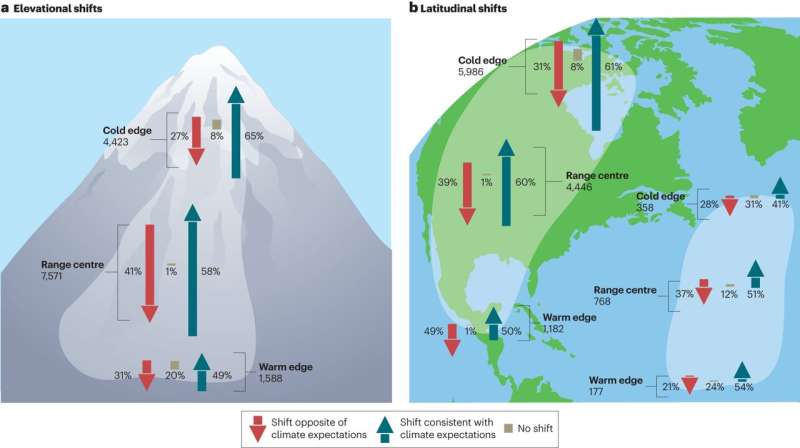This article has been reviewed according to Science X's editorial process and policies. Editors have highlighted the following attributes while ensuring the content's credibility:
fact-checked
peer-reviewed publication
trusted source
proofread
How climate change is affecting where species live

As the climate warms, many species are on the move, raising new challenges for policy-makers around the world. Shifts in the ranges of mosquitoes and disease-bearing ticks and bats are introducing illnesses such as malaria and Lyme disease into regions where health care systems are unprepared. Movements of commercially important fish from one jurisdiction to another are shifting job opportunities and causing trade disputes.
To help understand and anticipate when species will shift their ranges, an international team led by McGill University researchers has identified factors that have prompted or constrained shifts in the habitats of thousands of species around the world in recent decades.
McGill Ph.D. student Jake Lawlor, lead author of a study published recently in Nature Reviews Earth and Environment, explains, "Most systems in which humans use or interact with other species were built under the assumption that species would stay in place. Integrating range shifts that have already occurred, or might occur in future, into resource-management and conservation plans will be necessary as the effects of climate change continue to be felt."
Warming temperatures not the only factor
The researchers found that climate warming was a good basic predictor for the movements of most of the 26,000 species tracked in BioShifts, a global database. Indeed, 59% of species have shifted toward cooler environments.
In a substantial percentage of cases, however, the picture isn't as clear. In 41% of cases, species either failed to move at all, or moved toward new environments that were not consistent with warming temperatures. This inconsistency suggests temperature alone doesn't fully explain movements.
To better understand why some species are not shifting as expected, the researchers tried to find explanations in other species-specific or environment-specific factors.
"Understanding these temperature-inconsistent shifts will be especially important in helping researchers create models that predict when warming is likely to lead to range shifts, as well as when it won't," says Lawlor.
"For example, the type of life cycle of a particular species, or their sensitivity to warming, or the features of the landscape might help us to predict how likely the species in those habitats are to shift, and even the routes they might take."
Important gaps in the data
The researchers warn that the existing data on range shifts has been concentrated in Europe and North America, has been collected unevenly across plant and animal groups, and largely excludes marine species. They suggest this means there is a need for caution about the results.
For example, patterns seen where there are four seasons, such as in Europe and North America, may not apply to those where there are only wet and dry seasons, and species with different dispersal abilities (the ability to re-establish in new location) and growth rates are expected to respond differently.
"In other words, trends like averaged rates and directions of range shifts that we calculate based on observations of birds and insects might not tell us what to expect for shifts of kelp, or crops, or fish. Nor, as the climate changes, would they be sufficient to inform many conservation-management plans," notes Jennifer Sunday, the senior author of the paper and an Assistant Professor in the Biology Department at McGill University.
The team points to a need for increased monitoring of species shifts to improve the understanding of the factors at play and inform strategies for preserving biodiversity amid climate change.
More information: Jake A. Lawlor et al, Mechanisms, detection and impacts of species redistributions under climate change, Nature Reviews Earth & Environment (2024). DOI: 10.1038/s43017-024-00527-z
Journal information: Nature Reviews Earth & Environment
Provided by McGill University




















